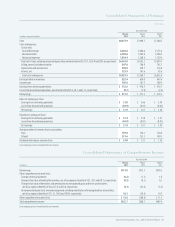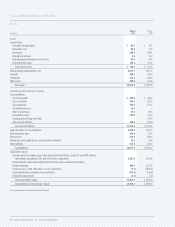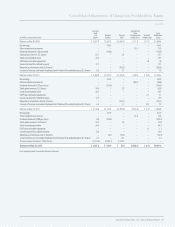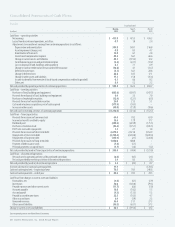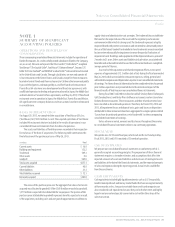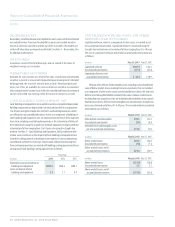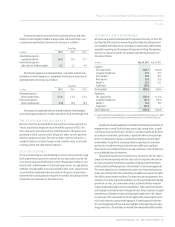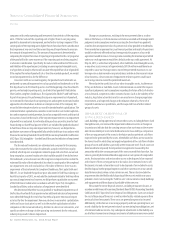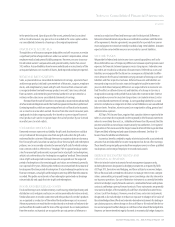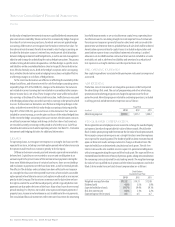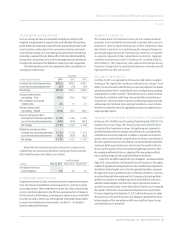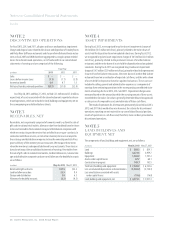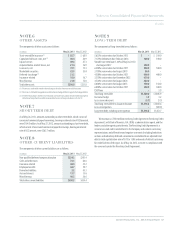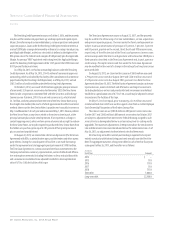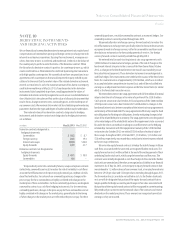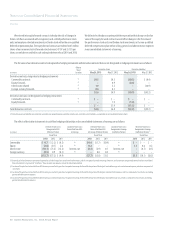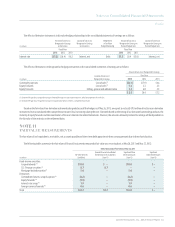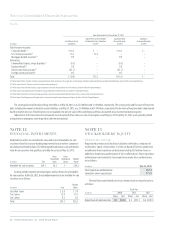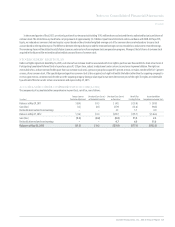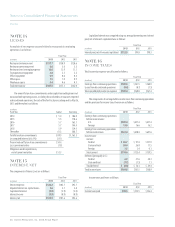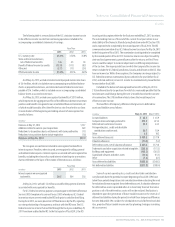Red Lobster 2013 Annual Report Download - page 49
Download and view the complete annual report
Please find page 49 of the 2013 Red Lobster annual report below. You can navigate through the pages in the report by either clicking on the pages listed below, or by using the keyword search tool below to find specific information within the annual report.
Notes to Consolidated Financial Statements
Darden
Darden Restaurants, Inc. 2013 Annual Report 45
NET EARNINGS PER SHARE
Basic net earnings per share are computed by dividing net earnings by the
weighted-average number of common shares outstanding for the reporting
period. Diluted net earnings per share reflect the potential dilution that could
occur if securities or other contracts to issue common stock were exercised or
converted into common stock. Outstanding stock options and restricted stock
granted by us represent the only dilutive effect reflected in diluted weighted-
average shares outstanding. These stock-based compensation instruments do
not impact the numerator of the diluted net earnings per share computation.
The following table presents the computation of basic and diluted net
earnings per common share:
Fiscal Year
(in millions, except per share data)
2013 2012 2011
Earnings from continuing operations $412.6 $476.5 $478.7
Losses from discontinued operations (0.7) (1.0) (2.4)
Net earnings $411.9 $475.5 $476.3
Average common shares
outstanding–Basic 129.0 130.1 136.8
Effect of dilutive stock-based
compensation 2.6 3.1 3.5
Average common shares
outstanding–Diluted 131.6 133.2 140.3
Basic net earnings per share:
Earnings from continuing operations $ 3.20 $ 3.66 $ 3.50
Losses from discontinued operations (0.01) (0.01) (0.02)
Net earnings $ 3.19 $ 3.65 $ 3.48
Diluted net earnings per share:
Earnings from continuing operations $ 3.14 $ 3.58 $ 3.41
Losses from discontinued operations (0.01) (0.01) (0.02)
Net earnings $ 3.13 $ 3.57 $ 3.39
Restricted stock and options to purchase shares of our common stock
excluded from the calculation of diluted net earnings per share because the
effect would have been anti-dilutive, are as follows:
Fiscal Year Ended
(in millions)
May 26, 2013 May 27, 2012 May 29, 2011
Anti-dilutive restricted
stock and options 2.8 2.6 1.2
COMPREHENSIVE INCOME
Comprehensive income includes net earnings and other comprehensive income
(loss) items that are excluded from net earnings under U.S. generally accepted
accounting principles. Other comprehensive income (loss) items include foreign
currency translation adjustments, the effective unrealized portion of changes in
the fair value of cash flow hedges, unrealized gains and losses on our marketable
securities classified as held for sale and recognition of the funded status related
toourpensionandotherpostretirementplans.SeeNote13–Stockholders’
Equity for additional information.
FOREIGN CURRENCY
The Canadian dollar is the functional currency for our Canadian restaurant
operations. Assets and liabilities denominated in Canadian dollars are trans-
lated into U.S. dollars using the exchange rates in effect at the balance sheet
date. Results of operations are translated using the average exchange rates
prevailing throughout the period. Translation gains and losses are reported
as a separate component of other comprehensive income (loss). Aggregate
cumulative translation losses were $1.8 million and $1.6 million at May 26,
2013 and May 27, 2012, respectively. Gains and losses from foreign currency
transactions recognized in our consolidated statements of earnings were not
significant for fiscal 2013, 2012 or 2011.
SEGMENT REPORTING
As of May 26, 2013, we operated the Olive Garden, Red Lobster, LongHorn
Steakhouse, The Capital Grille, Yard House, Bahama Breeze, Seasons 52 and
Eddie V’s restaurant brands in North America as operating segments. The brands
operate principally in the U.S. within the full-service dining industry, providing
similar products to similar customers. The brands also possess similar economic
characteristics, resulting in similar long-term expected financial performance
characteristics. Sales from external customers are derived principally from food
and beverage sales. We do not rely on any major customers as a source of sales.
We believe we meet the criteria for aggregating our operating segments into a
single reporting segment.
APPLICATION OF NEW ACCOUNTING STANDARDS
In February 2013, the FASB issued Accounting Standards Update (ASU) 2013-02,
Comprehensive Income (Topic 220), Reporting Amounts Reclassified Out of
Accumulated Other Comprehensive Income. This update requires companies to
provide information about the amounts reclassified out of accumulated other
comprehensive income by component. In addition, companies are required to
present, either on the face of the statement where net income is presented or in
the notes, significant amounts reclassified out of accumulated other comprehen-
sive income by the respective line items of net income. This update is effective
for us in our first quarter of fiscal 2014 and will be applied prospectively. Other
than requiring additional disclosures, adoption of this new guidance will not
have a significant impact on our consolidated financial statements.
InJuly2012,theFASBissuedASU2012-02,Intangibles–GoodwillandOther
(Topic 350), Testing Indefinite Lived Intangible Assets for Impairment. This update
simplifies the guidance for testing the decline in the realizable value (impairment)
of indefinite-lived intangible assets other than goodwill and allows companies
the option to first assess qualitative factors to determine whether it is necessary
to perform the quantitative impairment test. Companies electing to perform a
qualitative assessment are no longer required to calculate the fair value of an
indefinite-lived intangible asset unless the company determines, based on a
qualitative assessment, that it is “more likely than not” that the asset is impaired.
This update is effective for annual and interim impairment tests performed in
fiscal years beginning after September 15, 2012, which will require us to adopt
theseprovisionsinfiscal2014;however,earlyadoptionispermitted.Wedonot
believe adoption of this new guidance will have a significant impact on our
consolidated financial statements


